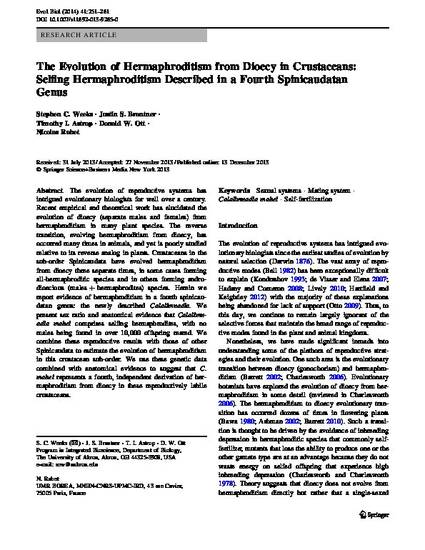
Article
The evolution of hermaphroditism from dioecy in crustaceans: Selfing hermaphroditism described in a fourth Spinicaudatan genus.
Evolutionary Biology
(2014)
Abstract
The evolution of reproductive systems has intrigued evolutionary biologists for well over a century. Recent empirical and theoretical work has elucidated the evolution of dioecy (separate males and females) from hermaphroditism in many plant species. The reverse transition, evolving hermaphroditism from dioecy, has occurred many times in animals, and yet is poorly studied relative to its reverse analog in plants. Crustaceans in the sub-order Spinicaudata have evolved hermaphroditism from dioecy three separate times, in some cases forming all-hermaphroditic species and in others forming androdioecious (males + hermaphrodites) species. Herein we report evidence of hermaphroditism in a fourth spinicaudatan genus: the newly described Calalimnadia. We present sex ratio and anatomical evidence that Calalimnadia mahei comprises selfing hermaphrodites, with no males being found in over 10,000 offspring reared. We combine these reproductive results with those of other
Spinicaudata to estimate the evolution of hermaphroditism in this crustacean sub-order. We use these genetic data combined with anatomical evidence to suggest that C. mahei represents a fourth, independent derivation of hermaphroditism from dioecy in these reproductively labile crustaceans.
Keywords
- Sexual systems,
- Mating system,
- Calalimnadia mahei,
- Self-fertilization
Disciplines
Publication Date
Winter January 1, 2014
DOI
10.1007/s11692-013-9265-0
Citation Information
Stephen C. Weeks, Justin S Brantner, Timothy I. Astrop, Donald W. Ott, et al.. "The evolution of hermaphroditism from dioecy in crustaceans: Selfing hermaphroditism described in a fourth Spinicaudatan genus." Evolutionary Biology Vol. 41 (2014) p. 251 - 261 Available at: http://works.bepress.com/stephen_weeks/28/
